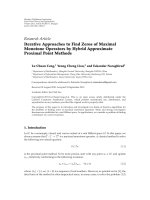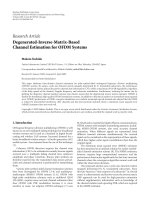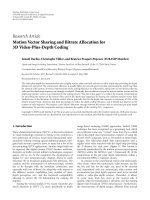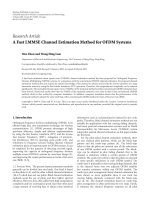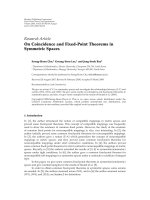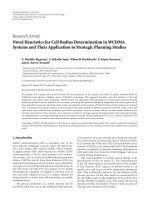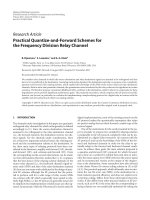Báo cáo hóa học: " Research Article Practical Approaches to Adaptive Resource Allocation in OFDM Systems" docx
Bạn đang xem bản rút gọn của tài liệu. Xem và tải ngay bản đầy đủ của tài liệu tại đây (927.19 KB, 10 trang )
Hindawi Publishing Corporation
EURASIP Journal on Wireless Communications and Networking
Volume 2008, Article ID 160307, 10 pages
doi:10.1155/2008/160307
Research Article
Practical Approaches to Adaptive Resource
Allocation in OFDM Systems
N. Y. Ermolova and B. Makarevitch
Department of Electrical and Communications Engineering, Helsinki University of Technology, P.O. Box 3000, 02015 TKK, Finland
Correspondence should be addressed to N. Y. Ermolova, natalia.ermolova@tkk.fi
Received 30 April 2007; Revised 6 September 2007; Accepted 28 September 2007
Recommended by Luc Vandendorpe
Whenever a communication system operates in a time-frequency dispersive radio channel, the link adaptation provides a benefit in
terms of any system performance metric by employing time, frequency, and, in case of multiple users, multiuser diversities. With
respect to an orthogonal frequency division multiplexing (OFDM) system, link adaptation includes bit, power, and subcarrier
allocations. While the well-known water-filling principle provides the optimal solution for both margin-maximization and rate-
maximization problems, implementation complexity often makes difficult its application in practical systems. This paper presents
a few suboptimal (low-complexity) adaptive loading algorithms for both single- and multiuser OFDM systems. We show that the
single-user system performance can be improved by suitable power loading and an algorithm based on the incomplete channel
state information is derived. At the same time, the power loading in a multiuser system only slightly affects performance while the
initial subcarrier allocation has a rather big impact. A number of subcarrier allocation algorithms are discussed and the best one
is derived on the basis of the order statistics theory.
Copyright © 2008 N. Y. Ermolova and B. Makarevitch. This is an open access article distributed under the Creative Commons
Attribution License, which permits unrestricted use, distribution, and reproduction in any medium, provided the original work is
properly cited.
1. INTRODUCTION
For a few last decades, the orthogonal frequency division
multiplexing (OFDM) has gained a lot of practical and re-
search interest because of the number of advantages that this
technique exhibits compared with the single carrier modu-
lation formats. These are primarily provisions of a high bi-
trate in a fading environment and relatively simple equalizer
structure. In OFDM, a high bitrate is provided by frequency
multiplexing where data is conveyed by a number of subcar-
riers. High spectral efficiency results from spectral overlap-
ping of the data conveyed by the different subcarriers and its
separation at the receiver is possible due to special assign-
ment of frequency spacing between the subcarriers. OFDM
is accepted as the standard in many current communication
systems (e.g., [1–3]) and is considered as a strong candidate
for next generation systems.
ButwhenanOFDMsystemoperatesinatime-dispersive
radio channel, the subcarriers with deep fading significantly
deteriorate reliability of the data transmission, that is, en-
hance the error probability. A way to support reliable data
transmission through spectrally shaped radio channels is
to load each subcarrier according to the channel state in-
formation (CSI). Under a constrained transmit power, the
well-known water-filling principle [4] gives the optimal so-
lution of the problems of maximizing the bitrate under a
constrained bit-error rate (BER) or BER minimizing under
providing a given bitrate. The former problem is called rate
maximization and the latter one is margin maximization [5].
Margin maximization is often formulated in the literature as
the problem of power minimization under fixed bit and bit-
error rates that is equivalent to the formulated above BER-
minimizing problem.
Duality between margin maximization and rate maxi-
mizationwasprovenin[6]. Particularly, this means that
a loading algorithm providing optimization of one prob-
lem yields the optimal solution for another one. Therefore,
without loss of generality we concentrate on the margin-
maximization problem in this paper.
For last years, the problem of adaptive resource alloca-
tion in OFDM has been studied intensively and as a result
a large number of algorithms have been developed on the
2 EURASIP Journal on Wireless Communications and Networking
basis of Campello’s conditions [5] providing implementation
of the water-filling principle in practical systems. For exam-
ple, a practical bit loading algorithm has been derived in [7],
noniterative power-loading strategies have been suggested in
[8, 9] and suboptimal water-filling algorithms with reduced
computational complexities have been presented in [10–12].
Many algorithms however have not found wide application.
The main reasons are still high computational complexity
of implementation caused by the iterative structure of the
algorithms and necessity to have a fresh (for mobile radio
channels) and accurate CSI at the transmitter. The latter re-
quirement results in a system overhead because of necessity
to have a (fast) feedback channel for the CSI transmission.
This fact and a sensitivity of the system performance to in-
accuracies of the CSI make adaptive power loading actually
unreasonable in mobile systems [13].
Recently, constant power suboptimal solutions have been
derived in [14, 15]. Both algorithms employ equal power
loading of a part of subcarriers. In [14], solely subcarriers
with the power gain values exceeding some properly chosen
power level are used for transmission, and in [15] the num-
ber of selected subcarriers is preliminary defined by the ini-
tial modulation format and is independent of specific power
gain values of the subcarriers. The ordered subcarrier selec-
tion algorithm (OSSA) [15]resultsinagoodBERperfor-
mance close to optimal in a Rayleigh environment and its
implementation complexity is very low because it is nonit-
erative and employs a constant constellation size. Addition-
ally, this method requires the CSI only in terms of “used-not
used” subcarriers.
Solely, power loading is another suboptimal approach
to the optimization problem. For example, in [16], we pro-
posed a low-complexity technique that consists in (quasi-)
inversion of subcarrier power gains. This technique pro-
vides a power gain at the expense of an additional over-
head resulting from necessity to have information about sub-
carrier power gains at the transmitter. But because of the
noniterative implementation procedure and a constant con-
stellation size, this is still a low-complexity power-loading
method. An interesting observation is that the combination
of the algorithms [15, 16] improves the performances of the
both algorithms and in some radio channels it results in
a power-loading technique with the performance close to
that of the much more complex optimal greedy algorithm
[17–19].
In this paper, we propose a BER minimizing power-
loading technique that employs only the CSI in terms of
“strong-weak” subcarriers and does not require complete in-
formation about the power gain values. The technique is
based on unequal power loading of the “strong” and “weak”
subcarriers. As the method in [16], it is noniterative and uses
a constant constellation size. We give the theoretical back-
ground and present simulation results that confirm efficiency
of the proposed algorithm for both single- and multiuser
cases. We prove that it provides a power gain in any time dis-
persive channel starting with some transmit signal-to-noise
ratio (SNR). In a “truncated” radio channel derived in [15],
the proposed method provides a power gain actually for all
practical SNR values.
OFDM has been recognized not only as an efficient mod-
ulation format but also as an effective way of supporting a
multiple access (e.g., [1, 20]). The orthogonal frequency di-
vision multiple access (OFDMA) principle employs assign-
ment of orthogonal subcarrier sets to a number of system
users. A lot of research activities have been focused on adap-
tive resource allocation for OFDMA and a large number of
techniques have been presented (see, e.g., [21–23]). In [21],
the authors present a heuristic algorithm based on construc-
tive initial subcarrier assignment with further iterations im-
proving the system power efficiency. Another computation-
ally efficient suboptimal algorithm employing fast initial sub-
carrier allocation and further iterative refinement is given in
[22]. In [23], both the optimal loading algorithm providing
different bitrate services with different target bit-error rates
(that is however NP-hard) and its reduced complexity ver-
sion are derived.
Most of the proposed algorithms are based on the water-
filling principle. It is worth mentioning that in a multiuser
environment, the water-filling principle does not provide
fairness between users in terms of the bitrates because it
always “encourages” “stronger” subcarriers by giving them
more power at the expense of the “weaker” ones.
In this paper, we study the margin maximization prob-
lem for an OFDMA system with a constant and equal bi-
trate for each user. A way to simplify implementation of
adaptive resource allocation in OFDMA is a disjoint sub-
carrier, power, and bit allocation. Herein, we further sim-
plify the optimization problem and restrict adaptive resource
allocation by only disjoint subcarrier selection and power
assignment.
We consider a number of subcarrier selection algorithms
and compare their performances for different channel statis-
tics. For the Rayleigh environment we prove that when using
subcarrier assignment with iterations over users, starting it-
eration from the “worst” user (i.e., with the smallest average
power gain) achieves better performance than the other user
orderings. The performance is similar to the initial construc-
tive allocation from [21] when it is combined with the OSSA
[15].
The observation that the OSSA releases a part of the sub-
carriers and thus has a potential for increasing the multiuser
diversity in multiple access has resulted in an extension of the
algorithm to OFDMA [24]. A low-complexity implementa-
tion of the OSSA in OFDMA includes initial subcarrier allo-
cation to users and next employing the OSSA for each user.
Only one adaptive initial subcarrier allocation algorithm was
presented and analyzed in [24] and it was shown that the ap-
plication of the OSSA provides a significant power gain while
the procedure of implementation is noniterative.
In this paper, we study combinations of the OSSA with
different initial subcarrier allocation schemes. We show that
the algorithm given in [24] is not the best one and on the
basis of the order statistics theory we propose a technique
that provides a better performance.
The paper is organized as follows. In Section 2,webrief-
ly describe the OFDM-OFDMA concepts and formulate
the optimization problem. Section 3 presents the proposed
power loading algorithm and subcarrier allocation schemes.
N. Y. Ermolova and B. Makarevitch 3
In Section 4, the simulation results are given and Section 5
summarizes and concludes the contents.
2. SYSTEM DESCRIPTION
2.1. OFDM-OFDMA basics
In an OFDM system with N subcarriers, the input informa-
tion data is mapped onto M-QAM constellation and in such
a way, a sequence of the N-dimensional input data vectors
is formed. The samples of an OFDM symbol are obtained
by the application of the N-point inverse Fourier transform
to an input data vector and next a cyclical extension of the
symbol with the last N
G
samples, that is, the so-called guard
interval is added at the beginning of each symbol.
The power efficiency η of the system is defined by the rel-
ative length of the information part of the symbol with re-
spect to its total length:
η
=
N
N + N
G
. (1)
In an OFDMA system, the N subcarriers are shared be-
tween the K users and a set of maximum L subcarriersisal-
located to each user.
2.2. M-QAM OFDM BER-performance
Since we consider the margin maximization problem, an an-
alytical expression for the BER is of interest.
In case of Gray coding, the BER on the ith subcarrier with
the power gain
|H
i
|
2
= x
i
is as [25]
BER
i
∼
=
a
M
erfc
b
M
x
i
,(2)
where erfc(
·) is the complementary error function, a
M
=
(
√
M−1)/
√
Mlog
2
√
M, b
M
= (E
i
b
/N
o
)(3log
2
(M)η/2(M−1)),
and E
i
b
/N
o
defines the transmit SNR of the ith subcarrier.
Averaging (2) through the subcarriers and channel statis-
tics results in the expression for average BER of the system:
BER
aver
=
1
N
E
N
i=1
BER
i
,(3)
where E means the expectation.
2.3. Optimization problem
The margin maximization problem can be formulated as fol-
lows.
(i) For a single-user OFDM,
min BER
aver
(4)
subject to
p
T
≤ p
max
,(5)
where BER
aver
is defined by (3)andp
T
denotes the
transmit power.
(ii) For OFDMA,
min BER
aver
=
1
K
E
K
k=1
π
k
∈π
P
π
k
·P
k
(6)
subject to
R
k
= R,(7a)
p
T
k
≤ p
max
(for the uplink) or
K
k=1
p
T
k
≤ p
M
(for the downlink),
(7b)
where R
k
and p
T
k
denote the bitrate and transmit
power of each user, respectively, π
k
is the set of L
≤ L
subcarriers allocated to the kth user and π is the set of
all possible permutations. In (6), P
π
k
denotes the prob-
ability of assignment of the set π
k
to the kth user and
P
k
is the conditional user’s error probability assuming
that the set π
k
is allocated to the user:
P
k
= 1/L
i∈π
k
P
er/H
ik
,(8)
where P
er/H
ik
is the error probability conditioned to the
specific subcarrier (characterized by the gain H
ik
)allo-
cation.
Aiming at low complexity of implementation, we restrict
ourselves by identical constellation sizes for each user. This
restriction combined with (7a) results in the equal number
of subcarriers allocated to each user.
3. PROPOSED ALGORITHMS
3.1. Power loading based on incomplete CSI
In this section, we derive an algorithm of unequal power
loading of “strong” and “weak” subcarriers.
Let all the subcarriers of a user be ordered according to
their power-gain values, that is, x
N
≥ x
N−1
≥ ···x
1
.Asin
[15, 16] we assume identical M-QAM modulation of each
subcarrier that considerably facilitates the transceiver imple-
mentation. Let the total transmit power per symbol be
P
= Nlog
2
M·E
b
,(9)
that is, E
b
is the power per bit under equal power loading of
all subcarriers.
The following lemma is valid.
Lemma 1. In any frequency-selective channel, the power-
loading algorithm
E
i
b
=
⎧
⎪
⎪
⎪
⎨
⎪
⎪
⎪
⎩
2kE
b
k +1
if N/2 <i
≤ N,
2E
b
k +1
if 1
≤ i ≤ N/2,
0 <k<1 (10)
always improves the average BER-performance (through the
subcarriers and channel statistics) starting with some transmit
SNR value.
4 EURASIP Journal on Wireless Communications and Networking
The proof is given in the appendix.
The procedure (10) assigns more power to the “weak”
half of subcarriers and actually is a simplified algorithm of
equalization of the received SNR. This method is opposite to
the optimal water filling. Generally, such power loading may
result in ineffective use of the transmit power since it is pri-
marily used for compensation of deep fading and according
to the lemma a power gain is observed only for high enough
transmit SNR values. But below we show that in some radio
channels, the proposed method provides a power gain actu-
ally for all practical transmit SNR values for both single- and
multiuser scenarios.
3.2. BER-performance analysis of
the power-loading algorithm
We assume that the channel power gains are identically and
independently distributed with the probability density func-
tion (pdf) f (x) and cumulative distribution function F(x).
Then the probability density function f
i
(x) of the ith order
statistic is [26]
f
i
x
i
=
N!F
i−1
x
i
1 −F
x
i
N−i
f
x
i
(i −1)!(N − i)!
. (11)
For example, for uncorrelated Rayleigh fading with a nor-
malized expectation E(x)
= 1,
f (x)
= exp (−x), F(x) = 1 −exp (−x). (12)
Using (11) we obtain that the BER
aver
under power loading
defined by (10)is
BER
aver
=
a
M
N
N/2
i=1
∞
0
erfc
b
M
2kx
k +1
f
i+N/2
(x)dx
+
∞
0
erfc
b
M
2·x
k +1
f
i
(x)dx
.
(13)
Since calculation of the BER
aver
in (3) involves the expec-
tation operation, the value of k minimizing (3) is essentially
defined by the channel statistics and can be found for exam-
ple numerically. We test the application of the power-loading
algorithm (10) in a “truncated” radio channel [15]because
the technique given herein is of low complexity and provides
performance close to optimal. In this case, the required CSI
at the transmitter is expressed in terms of “used strong-used
weak-not used” subcarriers. It turned out that in a single-
user case, for both Rayleigh and Nakagami (with different
scale parameters) independent fading, the optimal k value is
practically independent of N and E
b
/N
o
and is k
opt
∼
=
0.53.
The graphs of the BER
aver
versus k for a Rayleigh uncor-
related channel and the total number of subcarriers N
= 192
and N
= 96 are shown in Figure 1.ThecurvesinFigure 1 are
given for the case of applying the OSSA for the transmit SNR
values 5, 10, 15, and 17 dB.
3.3. Subcarrier allocation algorithms for OFDMA
We propose and analyze subcarrier assignment with iteration
over users based on the user average power-gain values:
M
k
= 1/N
N
i=1
x
ki
, (14)
where x
ki
=|H
ki
|
2
is a subcarrier power gain.
We order the users according to their average power-gain
values defined by (14) in such a way that
M
1
≤ M
2
··· ≤M
K
. (15)
Then at least two algorithms of subcarrier assignment
based on (15)canbeproposed.
Algorithm “W” (starting with the “worst” user). Each
user orders subcarriers according to the individual power-
gain values, that is, puts them in such a way that
x
k1
≤ x
k2
··· ≤x
kN
. (16)
Then the stronger subcarriers are assigned sequentially to
each user starting from the worst one (i.e., in the ascending
order in (15)). If a selected subcarrier of the user k has been
allocated to another user, the next ordered vacated subcarrier
of the user k is assigned to it.
Algorithm “B” (starting with the “best” user). The algo-
rithm is similar to the previous one with the difference that
the iteration over users is performed in the reverse order, that
is, in the descending order in (15).
Then the following lemma is valid.
Lemma 2. For an OFDMA system with equal us ers’ bitrates
operating in a Rayleigh channel, the initial subcarrier alloca-
tion according to Algorithm “W” always provides a better BER-
performance defined by (6) compared with Algorithm “B” un-
der other equal conditions.
The proof is given in the appendix.
4. SIMULATION RESULTS
Figure 2 presents the simulation results for the scheme where
the proposed power-loading algorithm based on the incom-
plete CSI is combined with the OSSA. The graphs are shown
for a single user with 256 subcarriers in an uncorrelated
Rayleigh channel. The number of subcarriers was chosen
according to the WiMAX standard [1]. Here the value of
k
= 0.53 was used. Other graphs in the figure show BER for
the ordered selection with equal power loading (k
= 1) [15],
ordered selection with subcarrier power gain inversion (la-
belled as inversion), described in [16], and optimal greedy
algorithm [17–19]. The simulation results for the systems
with the above power-loading algorithms but operating in
correlated Rayleigh fading are shown in Figure 3. The chan-
nel model used for the simulations was the reduced typical
urban channel [27].
It is seen that for both channels the algorithm (10)pro-
vides the BER-performance close to that under inversion of
N. Y. Ermolova and B. Makarevitch 5
10
−8
10
−7
10
−6
10
−5
10
−4
10
−3
10
−2
10
−1
BER
0.35 0.40.45 0.50.55 0.6
0.65 0.70.75
N
= 192
Power loading coefficient k
5dB
10 dB
15 dB
17 dB
(a)
10
−9
10
−8
10
−7
10
−6
10
−5
10
−4
10
−3
10
−2
10
−1
BER
0.35 0.40.45 0.50.55 0.6
0.65 0.70.75
N
= 96
Power loading coefficient k
5dB
10 dB
15 dB
17 dB
(b)
Figure 1: BER versus k in uncorrelated Rayleigh fading for different numbers of subcarriers.
10
−6
10
−5
10
−4
10
−3
10
−2
10
−1
10
0
BER
02 46 810
12 14 16 18 20
SNR (dB)
Inversion
k
= 0.53
k
= 1
Optimal
Figure 2: BER-performance of a few power loading schemes com-
bined with OSSA in uncorrelated Rayleigh fading, single-user case.
the subcarrier power gains. The observed difference results
from incomplete CSI in case of application of (10).
The simulation results for multiuser systems with the
above power-loading algorithms operating in Rayleigh un-
correlated and correlated fadings are shown in Figure 4 and
Ta bl e 1, respectively. For the former case k
opt
∼
=
0.75 and for
the latter k
opt
∼
=
0.9.
It is seen that proposed power loading improves the BER-
performance in all considered cases. This is more evident
for the single-user case where in both uncorrelated and cor-
related Rayleigh channels the performance of the proposed
method is close to that of inversion. However, for the consid-
10
−8
10
−7
10
−6
10
−5
10
−4
10
−3
10
−2
10
−1
10
0
BER
0510
15 20 25
SNR (dB)
Inversion
k
= 0.53
k = 1
Figure 3: BER-performance of a few power-loading schemes com-
bined with OSSA in correlated Rayleigh fading, single-user case.
Table 1: Log
10
(BER) versus SNR of OFDMA in correlated Rayleigh
fading; 8 users sharing 256 subcarriers.
SNR,dB101214161820
Invers.
−2.935 −3.662 −4.494 −5.422 −6.454 −7.611
k
= 0.9 −2.931 −3.653 −4.482 −5.406 −6.434 −7.594
k
= 1 −2.922 −3.641 −4.466 −5.386 −6.413 −7.576
ered multiuser cases, the proposed method is still beneficial
although the provided power gain is small in the considered
correlated Rayleigh channel.
6 EURASIP Journal on Wireless Communications and Networking
10
−8
10
−7
10
−6
10
−5
10
−4
10
−3
10
−2
10
−1
10
0
BER
0510
15
SNR (dB)
Inversion
k
= 0.75
k = 1
Figure 4: BER-performance of OFDMA with different power-
loading algorithms combined with OSSA in uncorrelated Rayleigh
fading; 8 users sharing 256 subcarriers.
10
−6
10
−5
10
−4
10
−3
10
−2
10
−1
10
0
BER
0510
15 20 25 30
SNR (dB)
a
b
c
d
e
Figure 5: BER performance of a few subcarrier allocation schemes
in correlated Rayleigh fading with equal power loading.
The performance estimates of different subcarrier allo-
cation schemes for OFDMA discussed in the Section 3.3 are
shown in Figures 5–8.
Performance of algorithms “W” and “B” in terms of
average BER was evaluated and compared with perfor-
mance of several other algorithms for subcarrier alloca-
tion. The algorithms were simulated in correlated and un-
correlated Rayleigh channels with different power-loading
techniques.
10
−12
10
−11
10
−10
10
−9
10
−8
10
−7
10
−6
10
−5
10
−4
10
−3
10
−2
BER
16 18 20 22 24 26 28 30 32
Number of users
SNR: 10dB
SNR: 12dB
SNR: 14dB
Figure 6: BER performance versus number of users in uncorrelated
Rayleigh fading; OSSA is applied.
Figure 5 shows the simulation results for the correlated
Rayleigh channel with equal power loading for all the sub-
carriers and 4-QAM modulation. As the channel model, we
use the reduced typical urban channel [27]. The algorithms
shown there are the following: (a) allocation by sorted chan-
nel gains with iteration over subcarriers similar to the ini-
tial constructive allocation in [21] with the difference that
we use a randomly permuted user order, (b) allocation by
channel gains normalized by the user’s mean gain and it-
eration over subcarriers, this normalization enhances fair-
ness and decreases the mean BER, (c) algorithm “W,” (d)
algorithm “B”, (e) allocation with iteration over users with
the randomly selected user order, this allocation was used in
[24].
As we can see from the figure, the best performance with
equal power loading is shown by Algorithm “b” and “W”
with “B” having the worst performance which validates the
lemma’s assertion.
Further, we combine the above-mentioned algorithms
with the OSSA. There are a few reasons for employing the
OSSA in OFDMA. Firstly, for a fixed number of the sys-
tem users, releasing a part of the subcarriers results in a
more effective use of multiuser diversity that improves the
system performance [24]. Secondly, the system capacity can
be enhanced by the allocation of the released subcarriers
to extra users. Clearly, increasing the number of the sys-
tem users deteriorates the error probability. However, the
tradeoff between the number of the users and BER per-
formance can be included into OFDMA design considera-
tions. For example, in Figure 6 we show the simulation re-
sults for the BER-performance of an OFDMA system with
256 subcarriers when the number of users, with 8 subcar-
riers allocated to each of them, is increased from 16 to 32.
The subcarrier allocation algorithm employed is that with
N. Y. Ermolova and B. Makarevitch 7
iterations over users with the randomly selected user order
[24].
Effects of different subcarrier allocation algorithms on
the BER-performance are shown in Figures 7-8. The simu-
lation results for the uncorrelated and correlated Rayleigh
channels with the same algorithms as in Figure 5 but ad-
ditionally employing the OSSA are presented in Figures 7
and 8, respectively. There we can see that the best perfor-
mance is shown by the algorithms “a” and “W” with the
worst performance again shown by “B” which validates the
lemma also in these environments. We observe that for all
the cases, the algorithm “W” achieves good performance
and that performance of the randomly permuted user or-
dering, algorithm “e”, lies in the middle between “W” and
“B”.
5. CONCLUSIONS
In this paper, we consider practical approaches to the prob-
lem of optimal resource allocation in OFDM-based systems.
We study both single- and multiuser systems and show that
the single-user system performance can be improved by a
suitable power loading and an algorithm based on the in-
complete channel state information is derived. We also show
that in a multiuser system the power loading only slightly af-
fects performance while the initial subcarrier allocation has
a rather big impact. A number of the subcarrier allocation
algorithms are discussed.
When deriving the algorithm of power loading, we as-
sume that only incomplete CSI in terms of the “strong” and
“weak” subcarriers is available at the transmitter. Under such
assumptions, we propose a technique of unequal power load-
ing of the “strong” and “weak” groups. We give the theoreti-
cal background and simulation results that confirm efficiency
of the proposed algorithm.
Actually, the proposed algorithm distributes the available
transmit power by giving more power to the “weak” group
and less to the “strong” one. Clearly, the technique approx-
imately (i.e., only on the basis of incomplete CSI) equalizes
the transmit SNR and thus it is an opposite one to the opti-
mal water-filling procedure.
We prove that the algorithm is efficient in any time-
dispersive channel starting with some transmit SNR value.
It is interesting that in a truncated radio channel suggested
in [15], the proposed technique gives a power gain actually
for all practical transmit SNR values. In fact, the combina-
tion with [15] renders a new power and subcarrier selection
algorithm for OFDM that achieves performance close to that
of the optimal (but rather complex in implementation) algo-
rithm, and therefore can be regarded as a simplified water-
filling technique.
Such features of the presented algorithm as the noniter-
ative structure, a constant constellation size, and a low over-
head allow to refer it to a group of low-complexity tech-
niques that make it attractive for practical implementation
in OFDM-based transmission systems.
For OFDMA, we study performance of subcarrier al-
location algorithms with iterations over users contrasted
to the more conventional approach of iteration over sub-
10
−7
10
−6
10
−5
10
−4
BER
78910111213
SNR (dB)
a
b
c
d
e
Figure 7: BER performance of subcarrier allocation algorithms
“a”–“e” supplemented by OSSA for uncorrelated Rayleigh fading.
10
−6
10
−5
10
−4
10
−3
BER
8 101214161820
SNR (dB)
a
b
c
d
e
Figure 8: BER performance of subcarrier allocation algorithms
“a”–“e” supplemented by OSSA for correlated Rayleigh fading.
carriers. We show that the performance of this scheme is
defined by user ordering. Particularly, we prove that the
algorithm based on the iteration starting from the worst
user (with the smallest average power gain) outperforms
other orderings. The analytical proof is validated by the
simulation results that also show that the suggested al-
gorithm achieves good performance with different power-
loading techniques, while performance of algorithms with
iteration over subcarriers depends on the chosen power
loading.
8 EURASIP Journal on Wireless Communications and Networking
APPENDIX
A.1. Proof of Lemma 1
The difference between the average BER for equal (non-
adaptive) power loading BER
eq
and the proposed algorithm
BER
adapt
is expressed as
BER
eq
−BER
adapt
= 1/N ×a
M
E
N/2
i=1
erfc
b
M
x
i
−
erfc
b
M
x
i
2
k +1
−
N
i=N/2+1
erfc
b
M
x
i
·2k
k +1
−
erfc
b
M
x
i
.
(A.1)
The following inequalities are valid for 0 <k<1,
2x
i
k +1
>x
i
,
2kx
i
k +1
<x
i
. (A.2)
The derivative of the erfc-function
d
dx
erfc
bx
=−
b
πx
exp (
−bx)(A.3)
and thus the function
F(x)
=
erfc
√
bx
exp (−bx)
(A.4)
is strictly decreasing for x>0.
Therefore, we obtain that for x
2
>x
1
,
erfc
bx
1
erfc
bx
2
>
exp
−bx
1
exp
−
bx
2
. (A.5)
For example, from (A.5) we have that
erfc
bx
1
>C×erfc
bx
2
(A.6)
if
x
2
−x
1
≥
ln C
b
,(A.7)
where C is a positive constant.
We compare components of the first and second sums at
the right-hand side (RHS) of (A.1) elementwise. We obtain
from (A.6) that each component of the first sum at the RHS
of (A.1) satisfies to an inequality:
erfc
b
M
x
i
−
erfc
b
M
x
i
·2
k +1
> (C − 1) ×erfc
b
M
x
i
·2
k +1
(A.8)
if
x
i
·2
k +1
−x
i
>
ln C
b
M
. (A.9)
Clearly, validity of (A.8)-(A.9)canbeprovidedbya
proper assignment of b
M
. Moreover, a value of b
M max
can be
assigned such that (A.8)-(A.9)holdforeachx
i
(1 ≤ i ≤ N/2).
At the same time, we have for each component of the second
sum at the RHS of (A.1) that
erfc
b
M
x
i
·2k
k +1
−
erfc
b
M
x
i
< erfc
b
M
x
i
·2k
k +1
(A.10)
and thus
erfc
b
M max
x
i
−
erfc
b
M max
x
i
·2
k +1
−
erfc
b
M max
x
i+N/2
·2k
k +1
+erfc
b
M max
x
i+N/2
>(C − 1)
×erfc
b
M max
x
i
·2
k +1
−
erfc
b
M max
x
i+N/2
2k
k +1
.
(A.11)
It follows from (A.11) that the left-hand side of (A.11)ispos-
itive if such is the RHS of (A.11). We observe that owing to
ordering x
i+N/2
>x
i
and thus if k × x
i+N/2
>x
i
the RHS of
(A.11)ispositiveforC
≥ 2. But even if k × x
i+N/2
<x
i
, the
RHS of (A.11) can be made positive by proper assignment of
the constant C that in turn can be provided by a large value
of b
M max
(see (A.6)-(A.7)).
Thus starting from some value of b
0
, the inequality
(A.11)holdsforb
M max
>b
0
. This means that the RHS of
(A.1) is positive that in turn proves that the proposed power-
loading procedure starting with some transmit SNR value
improves the average BER performance.
A.2. Proof of Lemma 2
Let the matrix of the channel power gains be X
={x
ki
} with
the elements ordered according to (15)and(16).
We consider two algorithms of the initial subcarrier al-
location that differ only by the first step. These steps of Al-
gorithm I and Algorithm II are those of Algorithm “W” and
Algorithm “B,” respectively. Then the error probability for
Algorithms I (II) will be BER
I(II)
:
BER
I
=
1
K
E
P
err/x
1N
, x
1N−L
+1
+
K
i=2
π
i
∈π
P
π
i
·P
I/π
i
,
(A.12)
BER
II
=
1
K
E
P
err/x
KN
, x
KN−L
+1
+
K−1
i=1
π
i
∈π
P
π
i
·P
II/π
i
,
(A.13)
where P
err/x
1N
, x
1N−L
+1
and P
err/x
KN
, x
KN−L
+1
are the error prob-
abilities conditioned to that the best subcarriers are allocated
to the worst and best user, respectively. The second compo-
nents in the brackets in (A.7)-(A.8) express the error proba-
bilities for the rest of the users (see (6)).
The difference between the second components of the
sums at the RHS of (A.12)and(A.13) is that the set π
L
is
N. Y. Ermolova and B. Makarevitch 9
assigned to the Kth user in (A.12) while in (A.13)itisallo-
cated to the 1st user, that is,
BER
II
−BER
I
=
1
K
−
E
P
err/x
1N
, ,x
1N−L
+1
−P
err/x
KN
, ,x
KN−L
+1
+ E
π
L
∈π
P
1/π
L
−P
K/π
L
P
π
L
,
(A.14)
where P
π
L
is the probability that a specific subcarrier set π
L
is assigned to the 1st (Kth) user.
The function erfc(
√
bx) that defines the error probabil-
ity in (A.14)(see(2)) is a rapidly decreasing function with
the rapidly decreasing derivative defined by (A.3). It follows
from (A.3) that the erfc-function decreases faster than the
exponential function that in turn means that the difference
between two values of the erfc-function in the area of large
arguments is smaller than that in the area of small arguments
if the difference of the small arguments is not smaller than
the natural logarithm of the difference of the large and small
arguments.
We observe that the first component of the sum at the
RHS of (A.14) is just defined by the difference of erfc-
function values in the area of large values of the argument
while the second component is defined by that in the area of
smaller argument values. We recall that the power-gain val-
ues of each user for Rayleigh fading are subject to the expo-
nential distribution and such are (x
1i
−x
1i−1
)and(x
Ki
−x
Ki−1
)
[26].
The expectations E
{x
ji
−x
ji−1
}, j = 1, , K decrease lin-
early as i decreases [26]andthusdueto(A.3) the RHS of
(A.14)ispositive.
Likewise we can prove that each next step of the initial
subcarrier allocation of Algorithm “W” provides a power
gain compared with that of Algorithm “B”.
ACKNOWLEDGMENT
This work was supported by the Academy of Finland.
REFERENCES
[1] IEEE Std 802.16e, “Air interface for fixed and mobile broad-
band wireless access systems amendment 2: physical and
medium access control layers for combined fixed and mobile
operation in licensed bands and corrigendum 1,” 2005.
[2] IEEE Std 802.11g-2003, “Wireless LAN medium access control
(MAC) and physical layer (PHY) specifications,” 2003.
[3] ETSI, “Radio broadcasting systems: digital audio broadcasting
(DAB) to mobile, portable and fixed receivers,” Tech. Rep. ETS
300 401, European Telecommunications Standards Institute,
Sophia Antipolis, France, August 1997.
[4] R. G. Gallager, Information Theory and Reliable Communica-
tion, John Wiley & Sons, New York, NY, USA, 1968.
[5] J. Campello, “Optimal discrete bit loading for multicarrier
modulation systems,” in Proceedings of IEEE International
Symposium on Information Theory (ISIT ’98), p. 193, Cam-
bridge, Mass, USA, August 1998.
[6] A. Fasano and G. Di Blasio, “The duality between margin max-
imization and rate maximization discrete loading problems,”
in Proceedings of the 5th IEEE Workshop on Signal Processing
Advances in Wireless Communications (SPAWC ’04), pp. 621–
625, Lisbon, Portugal, July 2004.
[7] J. Campello, “Practical bit loading for DMT,” in Proceedings of
IEEE International Conference on Communications (ICC ’99),
vol. 2, pp. 801–805, Vancouver, Canada, June 1999.
[8] N. Wang and S. D. Blostein, “Comparison of CP-based single
carrier and OFDM with power allocation,” IEEE Transactions
on Communications, vol. 53, no. 3, pp. 391–394, 2005.
[9] L. Goldfeld, V. Lyandres, and D. Wulich, “Minimum BER
power loading for OFDM in fading channel,” IEEE Transac-
tions on Communications, vol. 50, no. 11, pp. 1729–1733, 2002.
[10] L. Ding, Q. Yin, K. Deng, and Y. Meng, “A practical computa-
tionally efficient power and bit allocation algorithm for wire-
less OFDM systems,” in Proceedings of IEEE Internat ional Con-
ference on Communications (ICC ’06), vol. 12, pp. 5628–5633,
Istanbul, Turkey, June 2007.
[11] G.MiaoandZ.Niu,“PracticalfeedbackdesignbasedOFDM
link adaptive communications over frequency selective chan-
nels,” in Proceedings of IEEE International Conference on Com-
munications (ICC ’06), pp. 4624–4629, Istanbul, Turkey, June
2006.
[12] B. S. Krongold, K. Ramchandran, and D. L. Jones, “Computa-
tionally efficient optimal power allocation algorithm for mul-
ticarrier communication systems,” in Proceedings of IEEE In-
ternat ional Conference on Communications (ICC ’98), vol. 2,
pp. 1018–1022, Atlanta, Ga, USA, 1998.
[13] H. Liu and G. Li, OFDM-Based Broadband Wireless Networks.
Design and Optimization, Wiley-Interscience, New York, NY,
USA, 2005.
[14]W.YuandJ.M.Cioffi, “Constant-power waterfilling: per-
formance bound and low-complexity implementation,” IEEE
Transactions on Communications, vol. 54, no. 1, pp. 23–28,
2006.
[15] D. Dardari, “Ordered subcarrier selection algorithm for
OFDM-based high-speed WLANs,” IEEE Transactions on
Wireless Communications, vol. 3, no. 5, pp. 1452–1458, 2004.
[16] N. Y. Ermolova, “Low complexity power loading strategies in
OFDM-based transmission systems,” in Proceedings of the 17th
IEEE International Symposium on Personal, Indoor and Mobile
Radio Communications (PIMRC ’06), pp. 1–5, Helsinki, Fin-
land, September 2006.
[17] D. Hughes-Hartogs, “Ensemble modem structure for imper-
fect transmission media,” US Patent no. 4,679, 227, July 1987.
[18] D. Hughes-Hartogs, “Ensemble modem structure for imper-
fect transmission media,” US Patent no. 4,731, 816, March
1988.
[19] D. Hughes-Hartogs, “Ensemble modem structure for imper-
fect transmission media,” US Patent no. 4,833, 706, May 1989.
[20] P. Xia, S. Zhou, and G. B. Giannakis, “Bandwidth- and power-
efficient multicarrier multiple access,” IEEE Transactions on
Communications, vol. 51, no. 11, pp. 1828–1837, 2003.
[21] C.Y.Wong,T.Y.Tsui,R.S.Cheng,andK.B.Letaief,“Areal-
time sub-carrier allocation scheme for multiple access down-
link OFDM transmission,” in Proceedings of IEEE 50th Vehic-
ular Technolog y Conference (VTC ’99), vol. 2, pp. 1124–1128,
Amsterdam, The Netherlands, September 1999.
[22] L. Chen, B. Krongold, and J. Evans, “An adaptive re-
source allocation algorithm for multiuser OFDM,” in Proceed-
ings of the 7th Australian Communications Theory Workshop
(AUSCTW ’06), pp. 143–147, Perth, Western Australia, Febru-
ary 2006.
10 EURASIP Journal on Wireless Communications and Networking
[23] M. L.C Hoo, J. Tellado, and J. M. Cioffi,“DualQosload-
ing algorithms for multicarrier systems offering different CBR
services,” in Proceedings of the 9th IEEE International Sympo-
sium on Personal, Indoor and Mobile Radio Communications
(PIMRC ’98), vol. 1, pp. 278–282, Boston, Mass, USA, Septem-
ber 1998.
[24] N. Y. Ermolova and B. Makarevitch, “Low complexity adaptive
powerandsubcarrierallocationforOFDMA,”IEEE Transac-
tions on Wireless Communications, vol. 6, no. 2, pp. 433–437,
2007.
[25] K. Cho and D. Yoon, “On the general BER expression of one-
and two-dimensional amplitude modulations,” IEEE Transac-
tions on Communications, vol. 50, no. 7, pp. 1074–1080, 2002.
[26] H. A. David, Order Statistics, John Wiley & Sons, New York,
NY, USA, 1981.
[27] G. L. St
¨
uber, Principles of Mobile Communication,KluwerAca-
demic Publishers, Dordrecht, The Netherlands, 2001.
